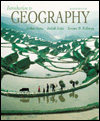 |  Introduction to Geography, 8/e Arthur Getis,
San Diego State University
Judith Getis
Jerome D. Fellmann,
University of Illinois, Urbana-Champaign
Cultural Geography
ProblemsWeb Page Questions:
Answer the following questions using the web pages provided.
1. Ethnologue - http://www.sil.org/ethnologue/countries (Languages of the World) a. How many languages are listed for the following countries?
| Australia | | Canada | | | China | | Denmark | | | Germany | | Guatemala | | | India | | Japan | | | Kenya | | Papua-New Guinea | | | Sierra Leone | | South Africa | | | United Kingdom | | United States | |
b. Of the top ten languages spoken by the world's population, how many countries
claim that language is spoken in their country? http://www.sil.org/ethnologue/names (Language Name Index)
| Chinese, Mandarin | | English | | | Spanish | | Bengali | | | Hindi | | Portuguese | | | Russian | | Japanese | | | German, Standard | | Chinese, Wu | |
Problems:
1. Universal Languages. Americans and the British are usually faulted for
not being bi- or multi-lingual. People in most other areas of the world learn
a second language, usually English, in addition to their native and regional languages.
As witnessed by history, as major a language becomes more commonplace, lesser-spoken
languages fall into disuse.
- Discuss a scenario in which the world has just a handful of functional
languages.
- How would this come about?
- What is a drawback to having only a handful of functional languages?
- What influenced the development of unique language groups over time?
- What has facilitated their demise?
2. Cultural Realms. A list of ten countries, spread across the globe, is given
below.
a) For each country, name the dominant religion, language family, and culture
realm to which it belongs. All information can be found in Chapter Seven.
| Country | Dominant Religion | Language Family | Culture Realm | | Australia | | | | | Brazil | | | | | Chad | | | | | Egypt | | | | | Germany | | | | | India | | | | | Kenya | | | | | Mongolia | | | | | Philippines | | | | | Saudi Arabia | | | |
b)Make a statement about the spatial relationship of
religion, language and cultural realm.
Critical Thinking Questions: - Discuss the statement "Plateaus have historically been the site of
unique groups and independent states."
- Pick a favorite food not native to the area in which you live and trace
it back to its place of origin. How did it get from its hearth to your table?
- Toponymy is the study of place names. Look a map of Minnesota at a scale
at which the smaller towns are shown. What can you refer from these names
as to the origin of the inhabitants that named them?
- Select one native clothing style (national costume) for each continent and
describe how it developed with relation to aspects of that area's physical
geography.
- Native or traditional architectural styles are a result of people's reaction
to conditions of weather and climate. Select five different architecture styles
and discuss of the each one's characteristic features was developed to address
a particular need.
|
|



 2002 McGraw-Hill Higher Education
2002 McGraw-Hill Higher Education

 2002 McGraw-Hill Higher Education
2002 McGraw-Hill Higher Education